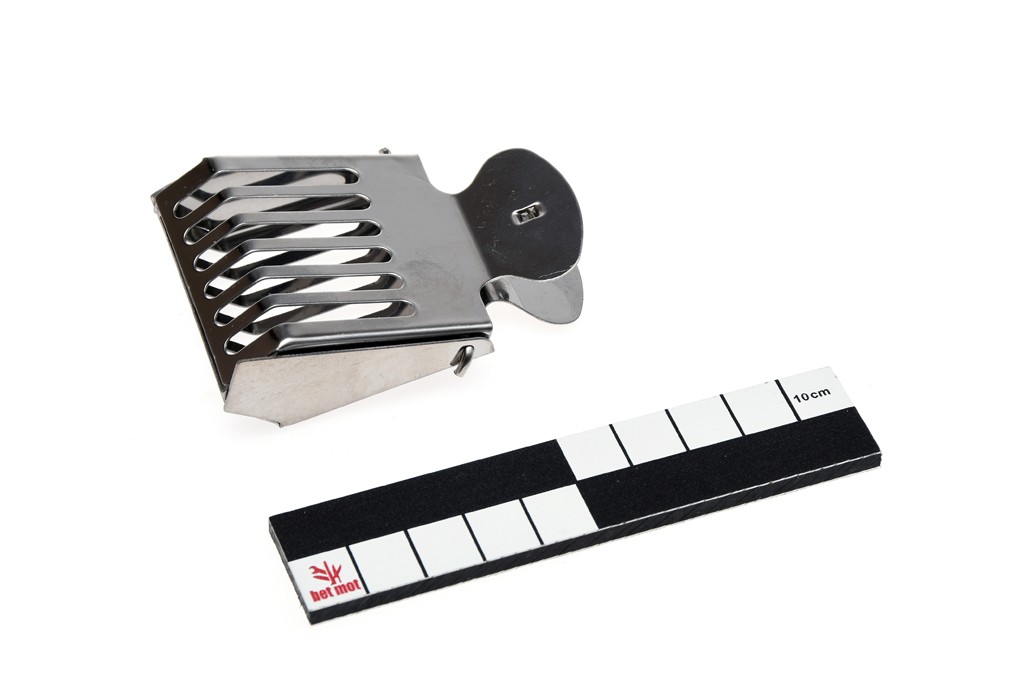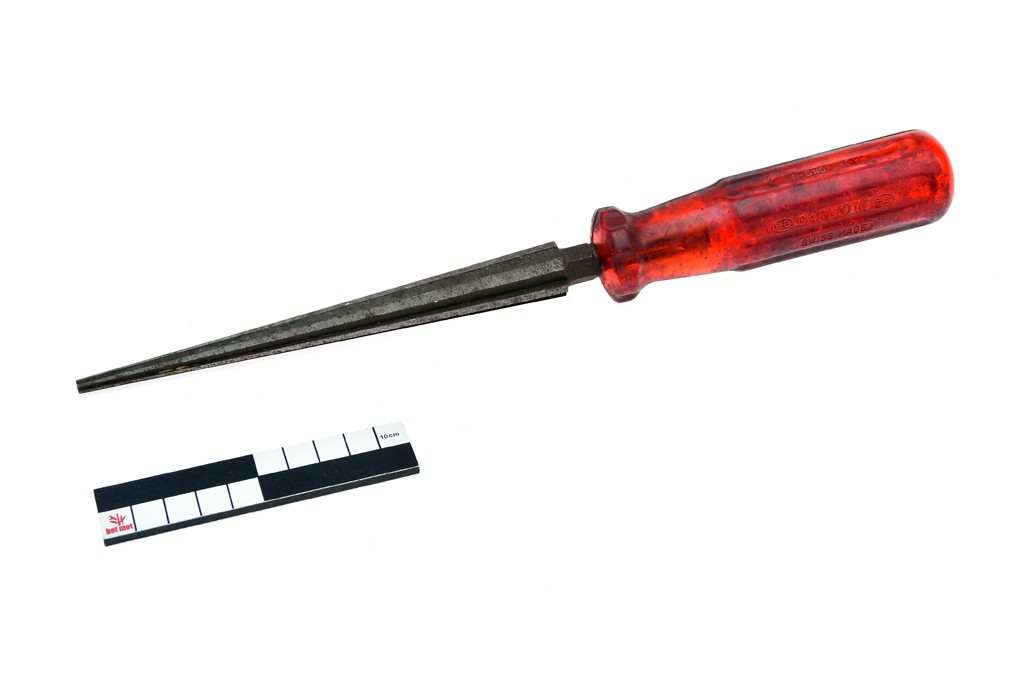ID-DOC: general search
Here you can enter a general keyword and perform a general search.
??? What are these question marks doing here? These represent tools which we know by a Dutch or French name, but who's English name is yet unknown. Suggestions are always welcome!
If you cannot find a certain tool, or if you experience other problems with this page, please let us know at info@mot.be.
Search for: tool
Showing search results 1,051 - 1,100
1,476 results found

Pumice stone
This text can only be consulted in Dutch
<https://www.mot.be/resource/Tool/pumice-stone?lang=nl>

Pump auger
Information about these tools and the experiment in 2019 to hollow an oak and compose a wooden water pump can be read on these pages. [MOT]

Pump drill
This text can only be consulted in Dutch
<https://www.mot.be/resource/Tool/pump-drill?lang=nl>

Punch
This text can only be consulted in Dutch
<https://www.mot.be/resource/Tool/punch-2?lang=nl>

Punch
Holes of different sizes can be made in leather with the aid of a punch,
i.e. a metal tube with sharp edges. The diameter varies from a few
millimeters to a few centimeters. A piece of leather is placed on a wooden,
lead or copper support in order not to damage the edge. The punch is then
placed where the hole is desired and hit with a hammer. So one needs his
two hands; this can be avoided for small holes with the punching tongs. See
also the cork borer. [MOT]

Punching block
This text can only be consulted in Dutch
<https://www.mot.be/resource/Tool/punching-block?lang=nl>

Punching tongs
See also the punch, buttonhole pliers and certain tongs of the sheet metal
worker.

Putty knife
The putty knife is used to apply putty to glass rebates. There are
different forms that are said to be regional. The blade can be pointed or
blunt, stiff or springy, straight or curved. The house painter uses the
putty knife, after priming the woodwork, to plug nail and screw holes with
putty. A rather rare model has small slots in the blade (1), just like a
glass cutter, to break off small pieces of glass. See also this coopers
knife and the oyster knife. [MOT] (1) See JACKSON & DAY: 170 and SALAMAN
1976: 251.

Putty scraper
After painting glass rebates, there is always some paint on the glass. With
the putty scraper, equipped with a safety or cutter blade, you can easily
scrape the paint off the window. The blade of the putty scraper is kept
almost parallel to the glass pane. Some models are used in the maintenance
of a ceramic hob. The blade between which the blade is screwed is made of
steel or plastic. The handle can be made of iron, wood or plastic. On some
models, the interchangeable blades are safely stored in the handle. Because
the cut is so sharp, the glass scraper is usually provided with a metal
protective cap or you can slide the top part of the handle so that it sits
over the blade. The knife of some models can be attached in different
positions (perpendicular, straight and oblique) in relation to the handle.
This way they can be used for other purposes. Eg. sharpening a pencil, as a
knife, to remove ice, labels, chewing gum, etc. from hard surfaces such as
glass, tile or cement. See also the cooper's...

Queen bee clip
This text can only be consulted in Dutch
<https://www.mot.be/resource/Tool/queen-bee-clip?lang=nl>

Quoin key
This text can only be consulted in Dutch
<https://www.mot.be/resource/Tool/quoin-key?lang=nl>

Rabbet plane
This text can only be consulted in Dutch
<https://www.mot.be/resource/Tool/rabbet-plane?lang=nl>

Racer
The racer serves to cut grooves on the inside of the leather to facilitate
folding. It is also used to draw stitching seams. The tool is always being
pulled towards you. The racer consists of a thick (about 3.5 mm) iron,
usually hook-shaped, blade (about 5.5 by 10 cm) of which the sloping side
is bent to form a cutting U-shaped point. The working part sticks by means
of a tang in a wooden handle (approx. 13 cm) that is reinforced with a
ferrule. Another model consists of a flat iron bar with one or both ends
bent into a scribe (1). The racer may also consist of a steel
tweezer-shaped tool with hooked or non-hooked ends (2). One end is bent and
cuts. The other end serves as a guide. With this model, a groove is cut
parallel to the edge of the piece of leather. A screw adjusts the width
(max. Approx. 2.5 cm) of the edge. To cut arcuate grooves in the grain side
of a piece of leather, a compass race is used. Can be distinguished from
the beam scribe. [MOT] (1) Eg. SALAMAN: 230. (2) Eg. SALAMAN:...

Racking hammer
Racking hammer (1) This text can only be consulted in Dutch (1) VAN HOUCKE: 603.

Radish decorator
This text can only be consulted in Dutch
<https://www.mot.be/resource/Tool/radish-decorator?lang=nl>

Rag wringer
The rag wringer is a device or hand tool with which you can easily wring
out a mop. One model is a perforated metal container (approx. 20 cm wide;
approx. 35 cm high) with a handle that can be hung over the edge of a
bucket. The wet mop is put in and the lever is pushed down; two sturdy
plastic parts now move down and squeeze the water out of the mop. A hanging
model with wooden rollers is hooked around a bucket. By pressing the handle
down, a roller on wheels moves towards a fixed roller to squeeze the water
out of the mop. A model of similar construction is built into a bucket and
is foot operated with a pedal. [MOT]

Rasp for wood
This text can only be consulted in Dutch
<https://www.mot.be/resource/Tool/rasp-for-wood?lang=nl>

Rasp, two handed
Very long rasp (approx. 120 cm; width up to 5 cm) with both ends ending or
sticking in a handle. The tool is handled by two men when grating heavy
red-hot iron. For example, when the axles of stretched vehicles are
delivered in two pieces and the blacksmith has to weld them together at the
correct length for the wheelwright. [MOT]

Rattail file
The rattail (1) is a cone-shaped or cylindrical file or rasp. The first is
to sharpen some saws with large teeth, eg a pit saw, the second is to clean
small holes or arcs.This hand tool can be distinguished from the drill saw.
[MOT] (1) Also ramasse (e.g. N.L.I.) to indicate the long cylindrical rasp
that widened the cavity for the ramrod of the rifle

Rawhide hammer
Hammer (approx. 600-1000 gr) of which the cylindrical head (approx. 7-8 cm
diameter) is made of leather, with a metal intermediate piece. It is often
possible to screw caps of different materials (rubber, nylon) onto the
intermediate piece. The handle is made of wood, plastic or metal. Another
lighter model has a cylindrical head that is completely wrapped in leather.
The leather hammer is used for machining material whose surface must not be
damaged. See also nylon face hammer and rubber face hammer. [MOT]

Razor knife
This text can only be consulted in Dutch
<https://www.mot.be/resource/Tool/razor-knife?lang=nl>

Razor strop
This text can only be consulted in Dutch
<https://www.mot.be/resource/Tool/razor-strop?lang=nl>

Reamer
This text can only be consulted in Dutch
<https://www.mot.be/resource/Tool/reamer?lang=nl>

Reaping hook
The reaping hook is used in combination with a flemish scythe. It serves to
keep the stalks together during the work and to gather the chopped grain
into a sheaf. The reaping hook has a curved or straight pointed iron hook
(approx. 15-30 cm) that is attached at right angles to a straight wooden
handle (approx. 80-100 cm). A slot is usually provided about 10 cm from the
end of the handle to insert the blade of the flemish scythe through so that
it can be carried over the shoulder. [MOT]

Rebate plane
This text can only be consulted in Dutch
<https://www.mot.be/resource/Tool/rebate-plane?lang=nl>

Record brush
The record brush is a hand tool to clean vinyl music records by wiping dust
and fingerprints without damaging the record. One model consists of a
rectangular and rounded oak block with a soft felt brush surface, usually
black. It somewhat resembles a whiteboard eraser. A slot is provided on one
side to store the accompanying cleaning fluid. Other models include bleach
goat hair or velvet. There is a wide variety of vinyl brushes in carbon and
plastics. Most of them are anti-static to rid the plate of its static
charge. [MOT]

Recorder brush
Long (approx. 20 cm), narrow brush with short (approx. 2 cm) woolen threads
twisted between an iron wire. The recorder brush is used to dry the
condensation in the inside of the flute (hole) after playing. The core gap
can simply be blown dry. [MOT]

Reflex hammer
This text can only be consulted in Dutch
<https://www.mot.be/resource/Tool/reflex-hammer?lang=nl>

Rescue knife
The rescue knife is an S-shaped or hooked (1) blade with an inside edge and
a knotted point, which is used by firefighters, emergency services, rescue
teams at car races, on rescue fleets, etc. to open or remove clothes, belts
or ropes. by cutting. The cut is on the inside and the tip is knotted so as
not to injure the victim. Often the knife sticks in a sheath that can be
attached to the belt. See also the window-smasher, the seat belt cutter and
the twine knife. [MOT] (1) SCHAERER: 626.

Riffler rasp / Riffler file
Riffler rasps and riffler files come in a wide variety of shapes, sizes
(approx. 12 to 50 cm) and coarse. Usually both ends of the tool have a
curved active part, but there are also models with a handle. The curved
shape makes it possible to finish complex profiles and hard to reach
corners and curves in wood, stone, plaster and metal. [MOT]

Ring dog
The ring dog is a heavy (1.5-4.5 kg) (1) pointed hook with one or two loose
ring (s) (diameter approx. 11-15 cm; entire length 30-50 cm) to tilt
trunks, to loosen a tree that has fallen on top of the other and sometimes
to pull small stumps out of the ground (2). A wooden stake (1.50-2 m) is
inserted into the ring with one end on the trunk. When it is pushed
upwards, the point of the hook first protrudes into the wood, then the
trunk tilts. When the latter could roll back, two men work together: the
first holds back the piece while the other grabs it again. There are also
adjustable models. The ring dog is mainly used in the forest. The cant hook
is used at the workplace. See also the sappie. [MOT] (1) HILF: 407. (2)
GAYER & FABRICIUS: 168; BOUCKAERT & POSKIN: 29.

Ring eye pliers
This text can only be consulted in Dutch
<https://www.mot.be/resource/Tool/ring-eye-pliers?lang=nl>

Ring rounding tool
This text can only be consulted in Dutch
<https://www.mot.be/resource/Tool/ring-rounding-tool?lang=nl>

Ring spanner
This text can only be consulted in Dutch
<https://www.mot.be/resource/Tool/ring-spanner?lang=nl>

Ring spanner for oil drain plugs
This text can only be consulted in Dutch
<https://www.mot.be/resource/Tool/ring-spanner-for-oil-drain-plugs?lang=nl>

Rip saw
This text can only be consulted in Dutch
<https://www.mot.be/resource/Tool/rip-saw?lang=nl>

Ripping chisel
This text can only be consulted in Dutch
<https://www.mot.be/resource/Tool/ripping-chisel?lang=nl>

Ripple
This text can only be consulted in Dutch
<https://www.mot.be/resource/Tool/ripple?lang=nl>

Rivet set
This text can only be consulted in Dutch
<https://www.mot.be/resource/Tool/rivet-set?lang=nl>

Roasting spit
This text can only be consulted in Dutch
<https://www.mot.be/resource/Tool/roasting-spit?lang=nl>

Roller docker
This text can only be consulted in Dutch
<https://www.mot.be/resource/Tool/roller-docker?lang=nl>

Roller-mincer
This text can only be consulted in Dutch
<https://www.mot.be/resource/Tool/roller-mincer?lang=nl>

Roofer's adze
This text can only be consulted in Dutch
<https://www.mot.be/resource/Tool/roofers-adze?lang=nl>

Roofer's hammer
Hammer (400-800 gr) used by the slater when covering or repairing a slate
roof. It is a composite tool that has a pointed end on one side - which
punch holes for the nails in the slates - and on the other side a hammer
end that drives the slate nails into the wood. In the middle, between the
two ends, there may be a pear-shaped cutout with which nails can be pulled
out. Another possibility is that there is a protrusion with a V-shaped
cutout at the top. Between the working part and the hammer handle there is
- on one or both sides - a sharp side with which the slates are cut to
size. This is done with the help of a slater's stake. [MOT]

Root extractor
This text can only be consulted in Dutch
<https://www.mot.be/resource/Tool/root-extractor?lang=nl>

Rose knife
This text can only be consulted in Dutch
<https://www.mot.be/resource/Tool/rose-knife?lang=nl>

Rosette iron
This text can only be consulted in Dutch
<https://www.mot.be/resource/Tool/rosette-iron?lang=nl>

Rotary grater
This text can only be consulted in Dutch
<https://www.mot.be/resource/Tool/rotary-grater?lang=nl>

Rotary herb chopper
This text can only be consulted in Dutch
<https://www.mot.be/resource/Tool/rotary-herb-chopper?lang=nl>

Rotary vegetable shredder
This text can only be consulted in Dutch
<https://www.mot.be/resource/Tool/rotary-vegetable-shredder?lang=nl>
